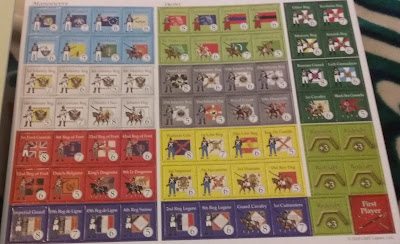General Andrew Jackson is besieging Pensacola. American reinforcements are hurrying south to join up with Jackson, but a Spanish detachment awaits them at the native village of Wannagama.
Game Notes
This morning I decided to play around with my copy of Manoeuvre. This time, I eschewed the command cards and simply used the boards and counters. Today's battle features 2 armies I haven't used yet - the Spanish and Americans. I decided the set the scenario in my home state of Florida, during a fictionalized version of the First Seminole War. In the real war, the Spanish protested American incursions but offered no resistance. But what if they fought the Americans?
For rules, I used Bob Cordery's Portable Wargame, specifically the late 19th century rules. I made a few tweaks, such as reducing musket range to 2 squares and adding an activation roll (using the Song of Blades and Heroes method). Furthermore, I did not use the Exhaustion rule.
I decided to use a scenario from One Hour Wargames (#9 - Double Delaying Action). In this scenario, the defenders (the Spanish) need to send 3 units as reinforcements off the board. However, they must also prevent the invaders from achieving their objectives (seize the village in the middle of the board and exit 2 units). The original scenario includes a river that must be crossed; my tiles don't have any rivers so I just used ones with lots of terrain instead. The armies are drawn randomly from the 8 counters in Manoeuvre. I designated units with a starting strength of 7-8 as elite (there are none on the American side), 6 as average, and 5 as poor.
The Battle
The American left (ironically the poor quality units) are the first to advance.
The Spanish cavalry drives back the American 3rd Infantry.
But they are cut down.
The American volunteer cavalry circles around to the road to Pensacola
In heavy fighting during the glaring Florida sun (I did not realize how bad the glare from my kitchen lights was) the Walloon Guards destroy the American 3rd.
Leaving 3 units to defend. One holds the native village of Wannagama, another blocks the road to Pensacola, while the Walloon Guards try to stymie the American advance.
The American 10th Infantry belatedly moves up in support.
The Americans break through the road, but they lose Wannagama!
Their efforts to retake the village fail!
By holding onto Wannagama, the Spanish barely emerge victorious.
Notes
- It has been a while since I played a OHW scenario. Two years ago, I began a project to play all 30 scenarios. I now have just one remaining! Here is my complete list.
- I never formally tried Portable Wargames before; I must say that it worked well. Combined with the scenario, it was an entertaining and exciting battle! I plan some more experiments with PW.






























